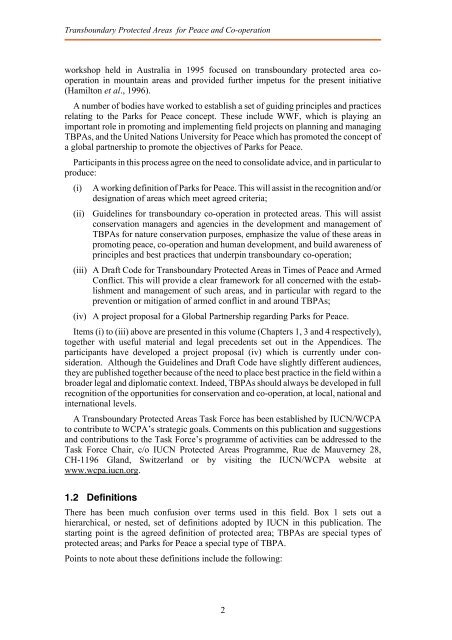Transboundary Protected Areas for Peace and Co-operation - IUCN
Transboundary Protected Areas for Peace and Co-operation - IUCN
Transboundary Protected Areas for Peace and Co-operation - IUCN
You also want an ePaper? Increase the reach of your titles
YUMPU automatically turns print PDFs into web optimized ePapers that Google loves.
<strong>Transboundary</strong> <strong>Protected</strong> <strong>Areas</strong> <strong>for</strong> <strong>Peace</strong> <strong>and</strong> <strong>Co</strong>-<strong>operation</strong><br />
workshop held in Australia in 1995 focused on transboundary protected area co<strong>operation</strong><br />
in mountain areas <strong>and</strong> provided further impetus <strong>for</strong> the present initiative<br />
(Hamilton et al., 1996).<br />
A number of bodies have worked to establish a set of guiding principles <strong>and</strong> practices<br />
relating to the Parks <strong>for</strong> <strong>Peace</strong> concept. These include WWF, which is playing an<br />
important role in promoting <strong>and</strong> implementing field projects on planning <strong>and</strong> managing<br />
TBPAs, <strong>and</strong> the United Nations University <strong>for</strong> <strong>Peace</strong> which has promoted the concept of<br />
a global partnership to promote the objectives of Parks <strong>for</strong> <strong>Peace</strong>.<br />
Participants in this process agree on the need to consolidate advice, <strong>and</strong> in particular to<br />
produce:<br />
(i) A working definition of Parks <strong>for</strong> <strong>Peace</strong>. This will assist in the recognition <strong>and</strong>/or<br />
designation of areas which meet agreed criteria;<br />
(ii) Guidelines <strong>for</strong> transboundary co-<strong>operation</strong> in protected areas. This will assist<br />
conservation managers <strong>and</strong> agencies in the development <strong>and</strong> management of<br />
TBPAs <strong>for</strong> nature conservation purposes, emphasize the value of these areas in<br />
promoting peace, co-<strong>operation</strong> <strong>and</strong> human development, <strong>and</strong> build awareness of<br />
principles <strong>and</strong> best practices that underpin transboundary co-<strong>operation</strong>;<br />
(iii) A Draft <strong>Co</strong>de <strong>for</strong> <strong>Transboundary</strong> <strong>Protected</strong> <strong>Areas</strong> in Times of <strong>Peace</strong> <strong>and</strong> Armed<br />
<strong>Co</strong>nflict. This will provide a clear framework <strong>for</strong> all concerned with the establishment<br />
<strong>and</strong> management of such areas, <strong>and</strong> in particular with regard to the<br />
prevention or mitigation of armed conflict in <strong>and</strong> around TBPAs;<br />
(iv) A project proposal <strong>for</strong> a Global Partnership regarding Parks <strong>for</strong> <strong>Peace</strong>.<br />
Items (i) to (iii) above are presented in this volume (Chapters 1, 3 <strong>and</strong> 4 respectively),<br />
together with useful material <strong>and</strong> legal precedents set out in the Appendices. The<br />
participants have developed a project proposal (iv) which is currently under consideration.<br />
Although the Guidelines <strong>and</strong> Draft <strong>Co</strong>de have slightly different audiences,<br />
they are published together because of the need to place best practice in the field within a<br />
broader legal <strong>and</strong> diplomatic context. Indeed, TBPAs should always be developed in full<br />
recognition of the opportunities <strong>for</strong> conservation <strong>and</strong> co-<strong>operation</strong>, at local, national <strong>and</strong><br />
international levels.<br />
A <strong>Transboundary</strong> <strong>Protected</strong> <strong>Areas</strong> Task Force has been established by <strong>IUCN</strong>/WCPA<br />
to contribute to WCPA’s strategic goals. <strong>Co</strong>mments on this publication <strong>and</strong> suggestions<br />
<strong>and</strong> contributions to the Task Force’s programme of activities can be addressed to the<br />
Task Force Chair, c/o <strong>IUCN</strong> <strong>Protected</strong> <strong>Areas</strong> Programme, Rue de Mauverney 28,<br />
CH-1196 Gl<strong>and</strong>, Switzerl<strong>and</strong> or by visiting the <strong>IUCN</strong>/WCPA website at<br />
www.wcpa.iucn.org.<br />
1.2 Definitions<br />
There has been much confusion over terms used in this field. Box 1 sets out a<br />
hierarchical, or nested, set of definitions adopted by <strong>IUCN</strong> in this publication. The<br />
starting point is the agreed definition of protected area; TBPAs are special types of<br />
protected areas; <strong>and</strong> Parks <strong>for</strong> <strong>Peace</strong> a special type of TBPA.<br />
Points to note about these definitions include the following:<br />
2

















